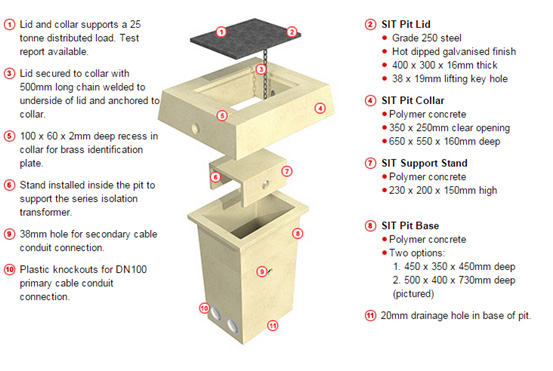Ready for Take-Off: ACO’s SIT Pit Range
Never heard of a Series Isolation Transformer? Then you’d be forgiven for failing to recognise a series isolation transformer (SIT) Pit in an airfield runway or taxiway lighting system. This, the most invisible of technologies, is not in the peripheral of most airway passengers – or even pilots or flight crew, for that matter. The SIT Pit is, to most people who pass over the runway, imperceptible yet vital.
What is a SIT Pit?
The role of the SIT Pit is to house SITs, transformers that maintain the functionality of airfield runway lighting systems. Take into account the immense activity of aircraft over runways and taxiways, and the sturdiness, integrity and durability of the pits becomes integral to the safe passage of air traffic, which heavily relies on lighting systems for landing and takeoff. SIT Pits are specially formulated to hold SITs for airfield runway lighting and in this, the most testing of environments; they must be sturdy enough to survive 24 hour air traffic operations.
What is a SIT?
A series isolation transformer is a piece of electrical equipment which ensures the continuity of the lighting electrical circuit in the event of one lamp in the series failing to function. Series isolation transformers also allow the delivery of the correct current to individual lamps, so that low voltage lamps can be, in effect, isolated from high voltage lamps.
SITs are used in airport runway lighting systems where constant current series circuits run. The airfield environment in which they operate requires 24 hour lighting of the runways for safe landing, take-off and passage of both air and land traffic. Airport lighting systems guide pilots through the layout of the airport, indicating taxiways, runways and terminal gates. The continued operation of lighting systems in this environment is crucial for the safe passage of aircraft and management of traffic. With the safety of thousands of people daily – or even hourly – depending on the functioning of the SITs, there is no margin for error.
Why is a SIT Pit important?
Perhaps now the importance of the Pit is coming to light. Without correct installation and use of materials, a failing SIT could cause catastrophe on the runway. For this reason, transformers should be enclosed and sheilded to prevent rattling and protected from the extremely heavy aircraft environment.
What materials are SIT Pits made from?
ACO’s SIT Pits are manufactured from durable, heavy duty materials including polymer concrete and galvanised steel to support loads of up to 25 tonnes. The image below represents a typical SIT Pit from ACO’s Cablemate range.

The compressive, flexural and tensile strength of polymer concrete far exceeds that of cement concrete, which is why ACO’s enclosures, Polycrete® Pits, are used in rigorous applications such as airside environments. Polymer concrete is a composite material made from polyester resin binder reinforced by mineral aggregates and fillers. The lids of our SIT Pits are manufactured from hot dipped galvanised steel. In some applications, a polymer concrete stand will also be necessary to support the series isolation transformer above the base of the pit.
Our SIT Pits sustain airfield lighting systems in airports across Australia. Domestic and International airports in New South Wales, Victoria, Queensland, the Northern Territory, South Australia and Western Australia are all home to ACO-manufactured SIT Pits. To learn more about ACO’s SIT Pits, Contact Us today or click here






